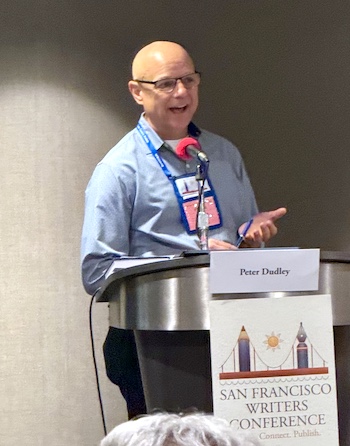Create an action plan because intention has a half-life
You always need an action plan because intention and inspiration have a half-life. An intention means nothing if you don’t follow through on it. An action plan is how you follow through.
On Sunday, I helped the attendees at the San Francisco Writers Conference create their action plan after four days of inspiration, education, and networking. But an action plan is important after every conference, training, meeting, and coaching session.
Without a solid, workable action plan, many of the attendees would probably have little to show for all their new inspiration, education, and intention a year from now.
Regular life quietly plots against you. Your new inspiration begins to degrade and dissipate the moment you step through those exit doors back into your normal life.

Inspiration continues to degrade with every email received, appointment scheduled, household chore done… soon you’re weeks down the road and you can barely remember what had you so inspired in the first place.
How to create a great action plan
Your action plan is just that: a plan to turn your intention into action. There’s nothing magical about it. Anyone can make one.
It starts with a well-defined intention and a clear understanding of why you care. It continues with a reasonable definition of success. Only then do you lay out your SMART goals, and you finish with how you’ll ensure that you follow through.
1. Be clear about your intention
Start with your personal goal. Name your intention. Go as big as you like. If you just finished a boot camp on launching a podcast, your intention may be “launch a successful podcast.” If you just finished a writer’s conference, your intention may be “get my novel published.” If you’re thinking of starting a business, that’s your intention.
It’s important to state your big goal in a way that other people can understand it. Without a goal, you can’t build a plan to achieve it. You can do stuff, but it may or may not lead to a goal. For example, if you create a logo and website, you may end up with a business in the end, but if you start with the goal of building a business, you’re much more likely to end up with a viable business… with or without a website.
Next, write down why this goal is important to you. What is inspiring you right now to achieve this goal? Don’t skip this step. This is your “north star,” the entire reason the goal exists. When things get tough and life knocks you sideways, you will need to reinvigorate the inspiration you feel right now. If you can’t articulate why this goal is important to you, it may already be a lost cause.
Now, write down what success looks like. Take a few minutes for this. Once you’re done, set it aside and forget it.
Now write down the absolute bare minimum of achievement you will be okay accepting if you complete this action plan. What is the least acceptable outcome that will make you say, “That was not a waste of my time/money/energy”? This will be important later on because people who only take the time to imagine the best-case version of success are far more likely to drop out after a setback. If you know what your bare minimum version of success is, you’re going to be much more likely to persevere through the psychological pitfalls that await.
To clarify: Shoot for the stars! Aim big! Articulating your minimum acceptable result is not about setting your sights low. It’s about getting clear about your quit criteria because if you don’t know when it’s truly time to quit, you also don’t know when you should keep going. Short-term discouragement is a powerful emotion that often causes people to quit when some worthwhile version of success is still well within reach.
Finally, write down who your audience will be. These are the people who are waiting for you to finish. They need your product, book, podcast, service, class… whatever you plan to accomplish, these are the people who need it. You’re working for them, now, too, not just yourself. Remember that when you feel like giving up.
2. Set SMART goals
Ask yourself this question: What do you intend to accomplish?
You may be saying “I just did that, you fool.” But you’d be wrong. You outlined your goal, which is not the same as what you intend to accomplish.
Success of any kind involves things that are outside your control. You can write a novel, but you can’t guarantee you’ll get a publishing deal. You can start a business, but you can’t guarantee it will take off. Luck, timing, and competition, among other things, will factor into whether you reach that goal.
An action plan, however, does not rely on luck or wishes. It’s a plan for the actions that you will take.
If your goal is to run a successful business, your action plan will be made up of tasks you need to accomplish toward that goal. Same with publishing a novel, running a nonprofit fundraising walk, winning a little league championship.
Your action plan will be unique to your goal, your capabilities, your timeline, your network, and other context that no one article can cover. I asked the attendees of the writers conference to think of the things they would accomplish in the next nine months. There were two components to this ask.
First, I wanted them to use the SMART goal framework. It’s straightforward: The goals you set should be Specific, Measurable, Achievable, Relevant, and Time-Bound. These criteria are exactly what they sound like. Following the SMART framework keeps you honest and doesn’t let you fall into the trap of magical thinking.
Next, I asked them to start with the end in mind and walk back their timeline. I asked them to write down SMART goals for these questions:
- In 9 months I will have accomplished:
- In 3 months I will have accomplished:
- This month I will do:
- This week I will do:
- Today I will do:
What you do today builds toward what you will accomplish this week, which builds toward what you will accomplish this month, in three months, and ultimately by your deadline.
Whether you take an optimistic or conservative approach to this exercise is immaterial. That’s a matter of style. Some people do better setting low goals and celebrating when they outperform them. Some do better setting high goals so they strive harder. Use what you feel comfortable with.
As long as your goals for each period are SMART, you’ll have a decent shot at accomplishing your action plan.
3. Plan to get the work done
Building an action plan is easy and fun when you’re in the moment of inspiration. Most people think they’re done with their action plan after writing down the timeline and the actions they plan to take.
Nope, you’re not hardly done. This is why so many plans fail. It’s why only 3% of people who start writing a novel actually complete a manuscript.
You have to know how you will make sure you complete the work, how you will rebound from setbacks, how you’ll protect your boundaries, and how you’ll celebrate successes.
Hold yourself capable
First, think about how you will hold yourself capable for completing this plan. What will you do to remember this moment, the inspiration you feel right now? What will you do to reinvigorate that inspiration?
- Use touchstones or mantras
A lot of people find that a small object or a phrase helps them re-focus on their intention. I keep the stone figurine of my gray bear nearby as an embodiment of what my brand represents. Some people put post-its on their computer or tape messages to their fridge. The one that works for you is the best one.

- Hold periodic meetings with yourself
Check in on what’s important to you. Keep your core values handy (or a list of what’s important to you about this project) and review them each week. Are they still true? How did you stay true to the list last week? How will you stay true to it in the coming week? - Go on field trips
When enthusiasm lags or other work starts to encroach on my plan, I sometimes go out on a field trip to find inspiration. When we were ideating the title and design of RELIT, for example, my partner and I went on bookstore safaris, checking out the many titles and talking about what we liked and didn’t like. We always came back reinvigorated and eager to move forward. - Think about your audience
Remember the “audience” you articulated earlier in this process? You’re working for them, now, too. If you’re building a business to provide prepared meals to busy families, then those busy families are eager and waiting for your product. The more you let your action plan slip, the longer they have to wait to get what they need.
Hold yourself accountable
Next, think about how you will hold yourself accountable for completing this plan. Here are a few things to consider:
- Make use of scheduling and tracking tools
Whether it’s an online calendar, a rolling to-do-list, project management software, or dry-erase markers on your bathroom mirror, find or create tools that work for you. Do not get stuck in the tar pit of researching these tools before working on your action plan. That’s just productive procrastination. - Review your timeline regularly
The timeline questions above intentionally use the phrases this month, this week, and today. You’re meant to review them regularly not only to ensure that you’re on track but also to adjust them more or less aggressive based on what actually happens over time. Your goal is your goal, and the action plan is there to help you achieve it. - Schedule retreats with yourself
Don’t just set time on your calendar to review your progress. Plan a retreat every month. My partner and I both work from home but hold a monthly two-hour retreat in a conference room at the library. The change in environment and limited, set-aside time focus us on the most important parts of the current action plan. The clarity you will gain will astonish you. - Name your external support systems
Who is paying attention to your success? For the conference attendees, it might be a critique group, a writing buddy, or just a friend who will keep bugging them for the next chapter. You have allies and cheerleaders. Who are they? Who will check in on your progress? Who besides you will be let down if you don’t keep going? - Stack your habits
If your action plan relies on creating new habits, try tacking those new habits onto existing habits. An example of habit-stacking is the guy who decided that he would do 15 push-ups before brushing his teeth every night. He added a new habit onto an existing one. For 15 years I took the train into the city for work. In order to write many of my novels, I took an earlier train and created a new habit of writing in a coffee shop before work. Stack the new habit onto something you already do for a better chance at getting it done. - Work with a professional coach
This may sound self-serving since coaching is what I do for a living, but the reality is that a skilled and experienced professional coach will not only serve as an accountability point but will also be an invaluable resource for overcoming obstacles, rebounding from setbacks, and keeping focused on achieving your plans.
Protect your boundaries
Now put some thought into how you will protect your boundaries. The rest of life is already conspiring to derail your action plan. Family obligations, work deadlines, illness, and even bad weather will all happen. How will you protect your action plan and make sure you keep it prioritized?
- When and how will you sacrifice your plan for something else?
This thing that’s important to you will never be as important to anyone else. You will need to not only set your line for when and how you’re willing to sacrifice your plan for other aspects of life, but also to make sure that others know where that line is and that it will be enforced. - Rely on your allies and support system
Get buy-in on your action plan early on from your loved ones and those who will need your time, attention, and energy. Ask them to support you on this journey, and get their permission to prioritize your plan over other things when you need to. - Keep track of your decisions
Humans are terrible self-reporters. We go by feel and often get the facts wrong. This is how two spouses can each be 100% convinced they are doing more than half the household chores. Don’t let your feelings be the governing factor for how and when you protect or loosen your boundaries. Keep track of the decisions you make so you can avoid both the resentment of sacrificing too much and the guilt of sacrificing too little.
Celebrate progress
Finally, think about how you will track and celebrate your progress. This is not a step to be overlooked. Most of us, high achievers especially, forget to celebrate milestones we achieve and forget to look back at just how far we’ve come from the beginning.
Celebrating progress is a huge part of maintaining momentum and keeping that feeling of inspiration fresh. If you are constantly pursuing success, you will never have success. Recognize that you are achieving success each time you accomplish what you committed to doing today, this week, this month.
Sticking to your action plan each day, each week, and each month is how you get to the big goals in the end. Being intentional about creating a robust, achievable action plan when you are in the middle of inspiration is how you achieve the intention that feels so important to you in this moment.
Connect with me
Free consultation
Looking for more fulfillment, joy, or direction in your life? Want to be a more courageous leader? Contemplating a career change? Have a book in you that you need to write? I can help. Schedule a free coaching session now.
Free core values exercise
This simple worksheet helps identify your core values. Many of my clients find it surprisingly eye-opening, and it’s helped people make some big life decisions. Get it here.
Download my chapter from RELIT free

RELIT: How to Rekindle Yourself in the Darkness of Compassion Fatigue gives practical, relevant, actionable advice on avoiding and overcoming compassion fatigue and caregiver burnout. As a professional coach, I have to pay close attention to self-regulation and my own personal resilience. My chapter explains the things I do to stay centered and stay focused so I can give every client my best, every time.
Download my chapter for free: Show up. Try hard. Be nice.



2 Comments
Knowing when it’s time to stop - Gray Bear Coaching LLC · July 14, 2025 at 7:41 am
[…] written before about action planning and quit criteria, but today I’m thinking about the feeling of being done. Not about achieving […]
How to quiet your high achiever guilt - Gray Bear Coaching · August 29, 2025 at 2:38 pm
[…] coaches love that kind of thing. Yes! we’ll cheer. SMART goals! Action plans! Prioritization of work! Time […]